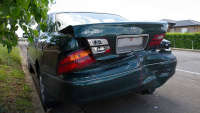Learning how to change a tyre is a very important skill to have in Australia so you don’t end up stranded by the side of a remote road.
While it could seem difficult, it isn't hard to change a flat tyre on your own, so long as you follow the basic principles and remember these safety tips.
Before you drive
Firstly, you should check the pressure of your tyres once a month, including the spare tyre. The pressure level will be on the tyre placard inside one of your car’s doors.
Most cars will only come with very basic tyre changing tools like a scissor jack and a universal wrench. These will often not be enough to complete changing a tyre on the roadside, so it is highly recommended you buy a good LED work light (with spare batteries), a solid rubber mallet to knock loose over-tight wheel nuts, a towel to lie on, work gloves, a piece of solid timber to place the jack on, and a red flashing emergency warning light.
Pop goes the tyre
If you’re driving when the tyre goes flat roll off the accelerator and pull over, coasting to the side of the road. Park far enough off the road you won’t be in danger of being hit by passing traffic, and don’t stop in the middle of a corner.
Replacing the tyre
1. Firmly apply the handbrake and put the vehicle in park (or in a gear for a manual transmission).
2. Turn the hazard lights on, hop out and look at where you’ve parked. You want to ensure you’re on flat, even ground that isn’t soft or have debris.
3. Remove the spare wheel from the car. Sometimes these are located inside the cargo area, but they can also be attached under the rear of the car on some vehicles.
4. Slide the spare wheel under the sill of the car, near where you will be lifting from. This way if the car slips off the jack it will fall on the spare, giving you enough space to re-position the jack and lift the car again.
5. Put your piece of timber under the sill of the car, and prepare to position the jack between it and the car.
6. Most scissor jacks will have a slot in the top that seats in a particular spot under your car. Check your car’s owner’s manual for the exact location the manufacturer wants you to lift the car from, as these can be in different places on different cars.
7. Before lifting the car off the ground crack loose the wheel nuts, remembering “left is loose, right is tight”. These will sometimes be very, very tight so you may need to hit the end of the wrench with a mallet to shock the nut loose.
8. With the nuts loosened lift the car off the ground until the tyre is clear. Be careful removing the wheel off the hub as many wheel and tyre units are very heavy.
9. Slide the spare wheel onto the hub and tighten the nuts up by hand in a criss-crossing pattern.
10. Wind the jack down so the spare is lightly touching the ground but the weight of the car is not yet on it, then do the wheel nuts up tight with the wrench.
11. Wind the jack all the way down and remove it, remembering to put it, the support timber, flat spare wheel and emergency light in their proper sections of the cargo area, so they don’t become lethal projectiles in a sudden stop.
Flat tyre repair cost
Sometimes a tyre can be fixed by a tyre shop with a plug kit, but there are plenty of other occasions where you’ll be shopping for a new rubber hoop. These vary from car to car, and you should not change the size of the replacement tyre that will go onto the wheel you removed.
Safety First
Changing a tyre is a simple procedure, however it is a potentially deadly job. If you aren’t sure where you’ve stopped is safe, try and move the car further off the road, or move to a straight section of road and leave the headlights and hazard lights on so you’re easy to spot.
If you’re not confident with lifting the car, handling the wheel or tightening wheel nuts, call a capable friend or roadside assistance for help.


.jpg)

.jpg)
.jpg)

.jpg)


.jpg)

.jpg)
.jpg)
.jpg)
.jpg)
.jpg)
.jpg)
.jpg)
.jpg)
.jpg)
.jpg)
.jpg)
.jpg)
.jpg)
.jpg)
.jpg)
.jpg)
.jpg)
.jpg)
.jpg)
.jpg)
.jpg)
.jpg)


.jpg)
.jpg)
Comments